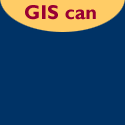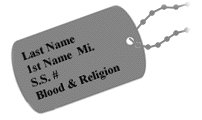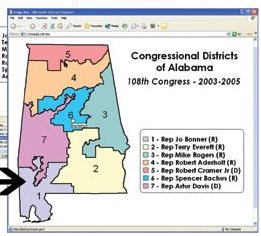Letters, Points of Interest, Kudos and Conundrums, Week in Review (Announcements, Contracts, Products, Events, Training, Hires) Back Issues, Advertise, Contact, Subscribe/Unsubscribe If, for some reason you cannot read this document, visit: http://www.gismonitor.com/news/newsletter/archive/090204.php
New Name for OGC
The press release explaining the change highlights that the organization is involved with standards far beyond GIS, and hence the "broader" term geospatial is more fitting. The release also suggests that the term helps tie into traditional IT and Web services, the new realm for both GIS and spatial standards. In the last few weeks USGS renamed its Geographic Information Officer the Associate Director for Geospatial Information. In the past few years Intergraph Mapping and GIS became Intergraph Mapping and Geospatial Solutions. Bentley's Geoengineering Business Group became Bentley Geospatial. The Defense Mapping Agency (DMA) and other groups were rounded up to become the National Imagery and Mapping Agency (NIMA) and most recently that agency was renamed the National Geospatial-Intelligence Agency (NGA). AM/FM became the Geospatial Information and Technology Association back in 1998. Intergraph's user conference is GeoSpatial World and the U.S. government's geodata access initiative is Geospatial One-Stop. There are a few holdouts. ESRI still holds firmly to GIS. MapInfo prefers location as in "location-based information." Oracle Spatial uses just part of the term. In the world of publishing GeoInfo Systems became Geospatial Solutions some years ago. GISWorld became GeoWorld and has many "Geo" friends in Geo:Connexion, and GeoTimes (geology). GIS User in Australia folded into Position in 2002. Again there are holdouts: GIS Development, GIS India, GIS Caf�, GIS Lounge, and (another) GIS User still keep the three-letter acronym alive. And of course, GIS Monitor does too. Is geospatial a "better" term than any of the others? Part of me feels that location, geospatial, spatial, and geographic are about equivalent. Another part of me is steeped in tradition, loyal to GIS, a term I first heard in grad school and later spoke daily in my career working at software companies. Are these terms really different? The American Heritage Dictionary of the English Language provides these definitions: Location: A place where something is or could be located; a site. Geospatial: no definition Spatial: Of, relating to, involving, or having the nature of space. Geographic: Of, or relating to geography. Google's tool for searching for definitions for "geospatial" yields two, both from government websites - one from New York and one from Florida. I suggest that the dearth of use of geospatial outside of "our world" means that it is "our word." The rest of the world doesn't use it, and maybe, doesn't know what it means. But we do. In fact, part of what I believe Intergraph, OGC, and others are doing is trying to define and own this "new" term for the areas of study and technologies relating to geography. Geospatial is broader than GIS, they argue; it entails more different kinds of technology. It reaches into IT, databases, sensors, the Web, and more. And, it must be pointed out, use of this term draws a sharp line of distinction between geospatial players and "ESRI, the world leader in geographic information system (GIS) software" as each press release from that company confirms. Does the name change matter, for OGC, GIS vendors, or the industry? I suppose within the industry, it matters little. We all have some idea of what GIS is, how it's broadened and can accept "geospatial" as a new term. For those outside our realm, I think there's still some puzzlement about what we do and the name change won't help one way or the other.
Attend GITA�s GIS for Oil & Gas Conference and explore how geospatial information can help you meet pipeline integrity and regulatory compliance challenges while maximizing your operations.
My first ID was issued in my junior year by the local public high school. I don't recall ever using it for anything, but I do still have it. College was another story. You needed your ID for entry into the gym, and I think, the library. Oddly, dining hall cards were not carried, but rather stored in racks just as you entered the buffet line. You took your card from the rack, handed it to the person collecting them, and got your lunch. Then a student refilled the racks for dinner. I don't believe they even had photographs on them! Did my early use of IDs link me to specific locations at specific times? Yes, but in a loose sort of way. If my ID was in the file box at the front desk at the gym, it could be determined I was likely in the gym or out running on campus. If my friend's dining hall card was not in its slot when I entered the line, it was likely he had already been through the line. But, those types of information weren't stored since there was no electronic scanning of the cards (I don't recall bar codes or magnetic strips) so I don't believe anyone could find out how many times I had lunch in any given week. Today I use an ID exclusively when I'm traveling by air. Unlike many readers, I don't work in a secured facility, nor do I have to prove my identity to anyone with any regularity. On the other hand, I use "loyalty" cards at the supermarket. Those cards or key fobs see significantly more action than my license and perhaps they do for others as well. While not really ID cards per se, the loyalty fob in particular does provide a measure of identification. Not long ago, I found a set of keys with a drug store loyalty fob attached. When I returned the keys to the nearest store in the chain, I was assured the staff could locate the owner. I don't believe there was any other information on the key ring that would allow the owner to be located. The airlines know my travel plans, but not directly from my ID. I book the reservation and check-in using a credit card (that's really an ID these days, isn't it?), and hand in my boarding pass when my row number is called. All of that information is contingent on my showing the proper ID at one place and time in the airport. (That's the case at Logan International, here in Boston. Your mileage may vary.) The airlines know when I was in San Diego and when I returned home. And, they certainly store that information in my frequent flier profile (for me) and in their database for marketing, and I suppose other reasons related to security. The grocery chain knows when I was at which store and what I purchased. And, that information is stored, too. But, old fashioned IDs are so useful, even if they do not allow any sort of locational tracking or long term data storage. We put old fashioned metal "dog tags" on our pets and our soldiers. Stewart the cat, who recently visited my house, sported a tag that noted his name, his owner's phone number, and the fact that he was deaf. That tag would be far more valuable to someone finding him than that same information coded on a chip under his skin, readable only with a special scanner. I read recently how New York City firemen, during 9/11, wrote their badge numbers in permanent marker on their arms so they could be identified should something "happen." Good old fashioned IDs still have tremendous value. The challenge of those IDs, and something I think the chipping advocates realize, is that carrying an ID requires effort and forethought. Stewart's owner had to have a special tag made up for him. Parents have to write their child's name in their clothing. And, many times during the day, at least in the United States, there's no reason to carry an ID. On the other hand, how many of us find ourselves pulled over in a car without a license? I'm the first to admit that I hate carrying anything extra, especially when doing the things where I'm most likely to get into trouble: biking and running. So wouldn't it be great to have a permanently embedded ID to solve the problem? One that travels with me, wherever I go? Maybe, but again simple solutions can solve the problem, too. Years ago I read an article that suggested that cyclists should use a sandwich bag to store some extra cash and contact information in case of an emergency. The bag was to be securely taped into the bottom of the bike seat. I've been lucky enough thus far that I never learned if those who found me would find the information (and cash). Still, it was a simple way to include the information. And, after running for 25 years without an ID, I just got around to ordering one of those bracelets specifically aimed at runners. I have a sneaking suspicion many people, myself included, are expending more energy worrying about tracking and privacy via electronics than they've given to the value of an up-to-date "analog" old fashioned ID.

The premise of location-based meeting services is that, simply, being near someone makes it easier to meet them. It sounds sort of silly, I know. But considering the principle of least effort and the challenges most people these days have in making and keeping appointments, the idea matches today's lifestyle. There are a number of offerings, worldwide, that use location, and sometimes other factors, as the key to face-to-face introductions. Dodgeball is the name of a mobile phone software package, and a service, available in 15 cities in the U.S. It even made National Public Radio this week. Says the Dodgeball website: "Tell us where you are, and we'll broadcast your location to all your friends and let you know if any friends-of-friends are within 10 blocks." So far the service is relatively free; users pay for the text messages sent. And, there is paranoia since location information is passed along. The system, it's said, "forgets" one's location after a few hours. Several articles I've read suggest that Dodgeball and its peers are simply the evolution of the online (and non-LBS) Friendster, an Internet friends-of-friends linking service. Playtxt was officially announced this week; it's been in stealth mode since the beginning of the year. The UK service offers users the opportunity to use the "six-degrees-of-separation via your mobile phone to meet friends." According to a press release, users meet people "by texting your location from your mobile (sending your postcode is easiest)." Playtxt then "tells you who is nearby who you know - you'll get to know how many degrees away from them you are, and who the people are who link you to them." It's 50p to send a message to someone via the network. Part of the charge goes to charity. WhoAt doesn't use SMS like the two services above, but rather a mobile or non-mobile Web browser. In addition to noting friends, it also introduces people to people to whom they have no "friend of a friend" connection. Jabberwocky, part of an Intel Research project called Urban Atmospheres, helps individuals identify "familiar strangers," that is, people with whom they cross paths regularly, but do not know. SmallPlanet uses personal profiles to find potential matches, delivering pictures to potential friends in proximity to one another. The one drawback? It relies on Bluetooth which means, as one review put it, you can only meet people who are "in the same room with you." Are these services changing how people meet and order their lives? I can't say I know a soul using one of these services, but then I may be a bit older than the target demographic. And, that in and of itself, is interesting. If this type of "recreational" use of LBS allows "the cell phone generation" to get comfortable with the issue of sharing, or not sharing, location, and other information, that's all the better for companies hoping to offer more expensive services. A user who is confident and comfortable with sharing which bar she's at may be more likely to pay the $5 per month for traffic information regarding her commute home, or the $19.95 to track her school-age daughter. It's also interesting to me that the "exactness" of a person's location, and its continued availability, is not that important for these services. These services use bar names or ZIP codes as key location information, making it quite easy or more difficult to track an individual. Most services are passive, that is, the user must key in and send the location data to the service, meaning he or she has complete control on when that information is shared. The fact that multiple offerings are available, often in the same city, is encouraging. So is the fact that different technologies (SMS, Bluetooth, browsers, and different phone operating systems) are in use. This looks to me like a giant, free testbed for location-based services to come.

A scholarship fund has been set up in his name at the university where he studied and later taught, UMass Lowell. The details for donating are online.
"Just a quick observation. It occurs to me that the term 'geospatial,' aside from being over-used, is redundant. Can something geographic not be spatial? I suppose something spatial might not be geographic, but I am not sure quite how. What is the point of changing the name from Geographic Information Office to the Geospatial Information Office? It accomplishes nothing, except to further confuse people who are trying to understand all the previous initiatives at USGS. I think someone at Interior is just enamored with the term. If anything, using the prefix 'geo' instead of geographic has the potential to create confusion among non-professionals as to whether 'geo' indicates geographic or geologic. "While I am at it, where did geographical come from? I have seen this pop up with increasing frequency over the last few years, and again, don't think it accomplishes anything except to use more unnecessary letters. Not much different from using 'utilize' when 'use' will do." The editor replies: I'm a big fan of "use."

Points of Interest Deals on GIS Books. The GITA bookstore is closing meaning good deals (up to 40% off) on new books on GIS and related technologies. While the association is getting out of the business of reselling titles from other publishers, I'm assured GITA will still publish and sell its Geospatial Technology Report and other research materials. What are "map miles?" A lost toddler was found in Missoula, Montana over the weekend. The odd part of the story is how the AP described his distance from a pond: "The boy was found about 1.7 'map miles' from Kreis Pond, but at least double that distance by ground miles." Does this mean "crow flies" vs. "on trail miles"? I, for one, am not familiar with the term "map miles." No More Geocaches? The Daily Camera (Boulder, Colorado) reports that geocaching may become illegal on Boulder County Open Space if members of the Board of County Commissioners follow their agenda Tuesday. Critics feel the sport leads to inappropriate use of off-trail areas and threatens plants and animals. While I do know of National Park Service regulations that have been used to prohibit caches, this is the first potential local ordinance of which I'm aware. Notes from AEC Automation. A few weeks ago I explained how SketchUp can be used to develop quick and pretty 3D models for use in ArcGIS. This past week Autodesk officially "canned" its product in that space, one called Architectural Studio. First released in 2002, the product helped spawn other technologies including DWF. Says Randall Newton at AEC Automation Newsletter: "The discontinuing of AAS leaves SketchUp from @Last Software as the primary architectural sketching product in the market." Also worthy of note is Newton's coverage of Bentley's acquisition of Haestad. He argues that Haestad's early choice of Microsoft's .NET development environment made the acquisition possible. He feels that it will allow the company's water models to be easily integrated with the Bentley product line. A new version of MicroStation, a year away, is expected to be wholly .NET-enabled. A reminder: AEC Automation recently moved from a subscription model to a free model. ZIP Code Man. Reader Zach sent in this link to an article about a fellow who has memorized all the ZIP Codes in the U.S. and uses the feat in his act in Boulder, Colorado. He's also memorized ZIP Codes worldwide and enjoys speaking to members of the audience in their native tongue. Three Hour Turn Around. The Airborne Rapid Imagery for Emergency Support (ARIES) project, developed by EarthData, Inc. and Solipsys (a wholly owned subsidiary of Raytheon), is supported by a grant from the Department of Homeland Security Office for Domestic Preparedness. It uses a digital sensor, LiDAR, thermal imaging, a high speed air to ground link and a mobile ground processing unit. The goal is to have useful imagery, in case of an emergency, within three hours of an event. A trial was held in late August; an official demo will be held in September in New Jersey. Cartographic Historian Passes. David A. Woodward, a British-born geographer, editor, and historian of mapmaking who helped create an encyclopedic series of books re-examining the place of mapmaking in world history, died Aug. 25. He taught at the University of Wisconsin for two decades. He was 61. He and a colleague, J.B. Harley, conceived the idea of a wide-ranging cultural history of mapmaking. They published but one volume.
Kudos and Conundrums Kudos (concepts we applaud) We are Going Local. A telephone survey of nearly 1,400 people held earlier this year by the Pew Internet and American Life Project and comScore Networks revealed that searching is the second most popular task done online. (E-mail is first.) More interesting to the geospatially inclined, "in March 2004, approximately seven percent of searches included a local modifier. Examples of local modifiers include city and state names, phone numbers, and the words 'map' or 'directions.'" Conundrums (concepts we question/give us pause) T-shirt Geography. "Hempstead, NY 516" was emblazoned on a t-shirt of a student who lived in the township on Long Island. 516 is the area code. Unfortunately, the student had moved to Gwinnett County, outside Atlanta where administrators assumed the reference was to an illegal substance. The student was yanked out of class and had to convince officials to search the Internet to confirm such a town did indeed exist before he was released. His father expects an apology.
Week in Review
Please note: Material used herein is often supplied by external sources and used as is.
PCI Geomatics was awarded the Small Medium Enterprise (SME) gold award for the Outaouais region by the National Bank of Canada. PCI will now move on to compete in the SME Quebec Provincial finals to be held in Montreal on October 29th, 2004. ITT Industries has acquired Allen Osborne Associates (AOA) the makers of high performance Global Positioning System (GPS) products for precise time and frequency transfer, surveying, ionsopheric calibration, and military receivers. ITT Industries has a long history supporting GPS as a provider of payload systems for every GPS satellite ever launched. This acquisition means that ITT will be able to leverage complementary technology between its space-based capabilities and ground systems for GPS. ORBIMAGE Inc., the satellite imaging company, announced that it has signed an agreement with Antrix Corporation of Bangalore, India to represent ORBIMAGE for distribution and resale of its satellite imagery products in India. � Contracts and Sales GeoAnalytics, Inc., of geographic and land information systems (GIS/LIS) technology and management consulting, has been retained by Oakland County, Michigan, to provide an Automated Vehicle Location (AVL) Web-based GIS Solution. DigitalGlobe has been awarded a contract to update the orthoimagery base program of the U.S. Department of Agriculture (USDA). The award was issued by the USDA's Farm Service Agency (FSA), Aerial Photography Field Office (APFO) for the Natural Resources Conservation Service (NRCS) 2004 Alaska Orthoimagery Project. It represents the first time satellite imagery has been used in the USDA's program. Applanix announced that Kingwood Forestry Services of Monticello, Arkansas, has purchased the latest version of its industry-leading DSS Digital Sensor System. The system will expand its aerial photography and GIS data acquisition capabilities for forest management. � Products DonationChannel Inc. announces the availability of dynamic, "on-the-fly" street address mapping capability for the Enhanced RealBird Aerial Maps Viewer. That is, it now has geocoding. This latest version of GPS.NET Global Positioning SDK is now available online for purchase and evaluation at the company's website. GPS.NET works with Visual Studio.NET 2002, 2003 and 2005 (a.k.a. "Whidbey") and supports desktop, PocketPC, and WindowsCE platforms. GPS.NET supports NMEA and Garmin protocols, with additional support for both serial and USB Bluetooth, Compact Flash, and Secure Digital devices. GPS.NET is "Windows Mobile" certified and was nominated this month for the PocketPC Magazine Best Software Awards 2004. GeoFields, Inc., a provider of managed data solutions for the pipeline industry, announced a new, enterprise-wide version of its RiskFrame Modeler for risk analysis on liquid and gas pipelines. Miner & Miner announced that ArcFM Solution 9.0.1 is now available.
Geosage has launched its advanced image fusion and pan-sharpening software HighView. With Geosage's state-of-the-art and highly efficient image fusion algorithms that have been developed over years, HighView successfully merges low-resolution color images with high-resolution black/white image of recent satellite images (e.g., QuickBird, IKONOS, and Landsat 7 ETM+). MapInfo Corporation announced the September 2004 release of MapInfo Professional v7.8, the newest version of the company's mapping and geographic analysis solution. This release marks the fifteenth anniversary of MapInfo Professional. GIS Monitor reported on the new version on August 19th. Blue Marble Geographics announced the release of a new version of the world's most recognized coordinate conversion libraries, GeoCalc.Net. This fully object-oriented version of Blue Marble's coordinate conversion libraries was created to meet the needs of cutting-edge Windows programmers.
Golden Software Inc. has upgraded its MapViewer thematic mapping package with more than 100 new features and enhancements. Among the new features is the ability to export maps with working hyperlinks directly from MapViewer to HTML Web pages. No HTML editing or coding is necessary. The product also supports U.S. address geocoding. Keyhole Corporation announced the introduction of a major upgrade to all components of the Keyhole enterprise system. The Keyhole 2 enterprise system introduces support for grid networks, enabling massive quantities of data to be processed across dozens of CPUs. � Events "From Pharaohs to Geoinformatics" is the title of the 8th GSDI Conference to be held 16-21 April 2005 in Cairo, Egypt. "The role of spatial data and spatial data infrastructures in an information society" is a major theme. The GSDI Association (Global Spatial Data Infrastructure) will hold this conference in conjunction with the Federation of International Surveyors (FIG). The GSDI Association invites representatives from government, industry, non-government organizations, and academia to respond to the GSDI-8 call for papers by November 20, 2004. � Training � Hires
GIS Monitor Back Issues
Advertise With Us
Contact GIS Monitor is published by: GITC America, Inc.
Subscribe/Unsubscribe |



